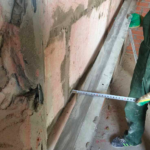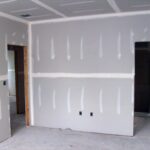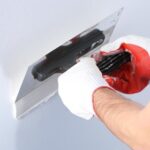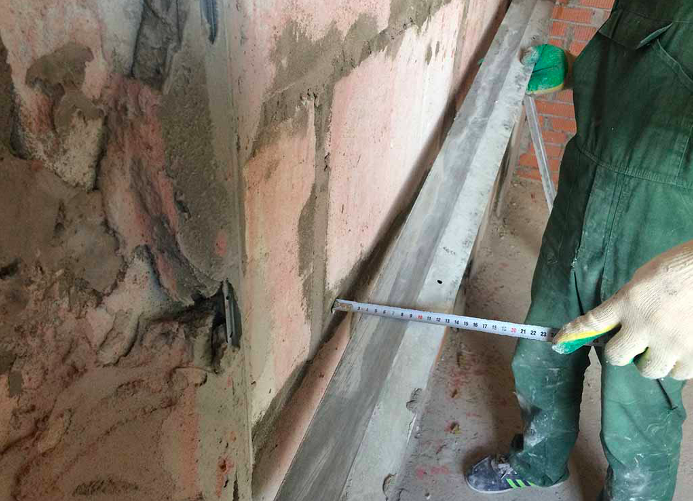Plastering plasterboard under wallpaper with your own hands: how to seal it, how to treat it
Plastering plasterboard under wallpaper is a mandatory stage of finishing work. It is carried out in several stages, starting with surface preparation and ending with the application of the finishing composition with further wallpapering. Step-by-step instructions and practical advice from professionals can be found in the presented material.
The content of the article
Materials and tools
When studying the question of how to plaster drywall under wallpaper with your own hands, you need to prepare materials and tools, as well as choose the right mixture. The rules are quite simple - if there is high humidity in the room (kitchen, bath, sauna), cement compounds should be used. If this is an ordinary room, for example, a living room or bedroom, it is allowed to use gypsum plaster, which is more flexible and economical in consumption.
Before you start studying the instructions on how to seal drywall joints under wallpaper, you should prepare the tools and materials for the job:
- soft spatula;
- a set of metal spatulas;
- bucket;
- a construction mixer or a drill with an appropriate attachment;
- roller;
- sickle tape;
- brushes with wide bristles;
- primer;
- wallpaper glue;
- sandpaper.
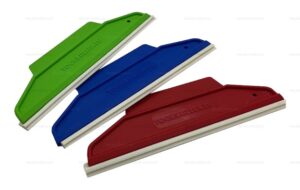
You also need to figure out how to finish the drywall. It is better to choose a high-quality composition based on gypsum or cement, depending on the microclimate in the room.Moreover, mixtures are classified according to their intended purpose. Starting compositions are used, spending 1-1.2 kg per 1 m2, and finishing compositions spend less - 0.5-1 kg for the same area.
When choosing how to treat drywall against moisture, you need to take into account not only the area, but also the nature of the surface. If there are quite a lot of defects and they are deep (10 mm or more), choose starting plaster. It is also important to know that the coarse-grained composition should be applied in a thick layer, so the consumption will be higher. Finally, it is recommended to take the mixture with a reserve of 10-15% in case of unforeseen expenses.
Surface preparation and sealing of joints
Before treating drywall from moisture, you must carefully inspect the surface and prepare it:
- if there are self-tapping screws, tighten them so that the head remains flush with the surface, but does not sink too much into it;
- if there is peeling of drywall, tear it and glue it along the same contour;
- prepare a container in advance for discarding dried putty.
Next, prepare the drywall putty with your own hands under the wallpaper. The mixture is poured into a bucket and diluted with a small amount of water (but not vice versa). It is better to cook in small quantities so that you can use the raw materials immediately without letting them dry out.
Now you can start finishing work, the first stage is sealing the joints:
- Take sickle tape and glue it over the joints of the sheets.
- The putty is placed in the joint, after which the tape is glued and embedded directly into the mixture.
- The solution is taken with a medium-sized spatula, and then distributed with a wide spatula along the wall. Do-it-yourself puttying of drywall under wallpaper is carried out so that there are no lumps or protruding irregularities.
- When the layer is completely dry, begin sanding the wall using sandpaper.
- The screws also need to be puttied using cross-shaped movements - across and along. To avoid lumps, it is important to ensure that there is no old mortar on the surface of the spatula.

Corner finishing
It is clear how to putty plasterboard under wallpaper with your own hands - for this they use cement or gypsum compounds. It is with these mixtures that the corners are treated, having previously reinforced them with sickle tape. It can be fixed before finishing or after it - the order of actions does not matter.
The main stages of finishing plasterboard walls for wallpaper are as follows:
- Apply the compound on one side of the corner.
- When the mixture dries, putty the other side.
- Apply the composition in small quantities - at least 2 times less than when finishing the walls.
- You can spread it on the corner of a spatula.
Instructions for plastering walls
Now it’s time to figure out how to properly plaster drywall under wallpaper. The main stages of work are as follows:
- First, the surface is finished with a deep penetration primer composition. It is applied with a roller or wide brush. You need to treat the entire wall so that there are no dry spots left.
- When the primer has dried, the starting plaster of the plasterboard walls under the wallpaper is mixed.
- The mixture is taken on a medium-sized spatula, after which it is distributed over the blade of a wide tool and applied to the wall, distributing evenly and making sure that no lumps form.
- As soon as the starting layer has dried, it is again treated with a primer.
- You also need to plaster the drywall under the wallpaper with a finishing compound. It is diluted according to the instructions and applied in a very thin layer using a spatula.
- After the last layer has dried, it is sanded until a smooth, monolithic surface is obtained.Then you can start gluing the wallpaper.
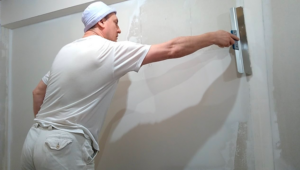
If you have covered the walls with plasterboard, it is clear what to do next. It is important to plaster them to get the smoothest surface possible. This is a mandatory stage of finishing work, which you can do yourself. The quality depends on how the surface is prepared and what composition is chosen.

